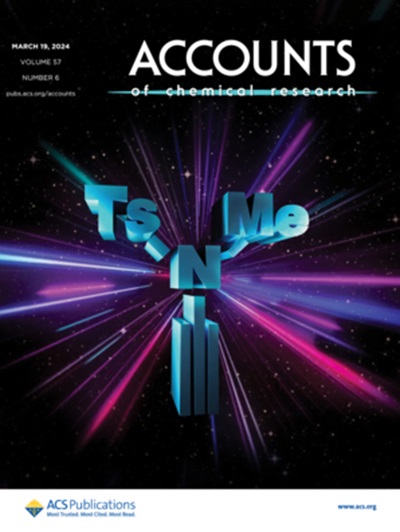The Chemistry Behind and Beyond the Molecular Engineering of 1,7-Naphthiporphyrin
IF 17.7
1区 化学
Q1 CHEMISTRY, MULTIDISCIPLINARY
引用次数: 0
Abstract
The discovery of 1,7-naphthiporphyrin was based on a specific naphthalene connectivity that disrupts naphthalene’s local aromaticity, and its global aromaticity was experimentally confirmed without dispute. Its unique conjugated pathways inspired our molecular engineering approaches─an unprecedented strategy for modifying the core structure of porphyrinoids. The first synthesis of o-styreniporphyrin was achieved in a truncated form, and further truncation yielded allyliporphyrin. Both compounds exhibited dynamic behavior in solution, including observable vinylenic bond rotation. Similarly, 1,7-naphthiporphyrin was converted into naphthioxacorrole by removing one meso-like carbon; its oxidized form featured an enedione unit that underwent selective sulfur or nitrogen nucleophilic addition, accompanied by color change. To obtain a larger macrocycle, we synthesized dimeric forms of 1,7-naphthiporphyrin, which exhibited a conjugation pathway approximating a 22π system (although a 34π system is also possible). As another possible approach, the naphthalene moiety of 1,7-naphthiporphyrin was expanded to anthracene, whose central ring acted as a diene and reacted with DMAD (a dienophile) to yield a new phlorin structure. Similarly, o-styreniporphyrin was expanded with naphthalene and anthracene; interestingly, its aromaticity decreased with increasing polycyclic aromatic hydrocarbon (PAH) size. Its aromaticity was evaluated by analyzing conformers and tautomers at equilibrium and considering their calculated energy levels. Functionalized allyliporphyrins were used to address an unresolved question in physical science: do electron-donating (ED) or electron-withdrawing (EW) groups reduce aromaticity? Allyliporphyrins─which offer more space at one meso-like position due to the partial removal of the naphthalene unit and the presence of both inner and outer CH groups─facilitated the evaluation of global aromaticity upon ED or EW substitution. Our experiments support the conclusion that both ED and EW groups reduce aromaticity. We then examined whether Clar’s sextets always contradict resonance theory. Some porphyrinoids derived from 1,7-naphthiporphyrin contain PAHs that allow the identification of two distinct Clar’s sextets─shared and independent─relative to the global conjugated pathway. To enable direct comparison, regioisomers of o-vinylnaphthiporphyrins were synthesized using our synthetic strategy. Sextet analysis of three regioisomers predicted that 3,4-vinylnaphthiporphyrin is the most aromatic (with an independent sextet), 1,2-vinylnaphthiporphyrin is next (with an independent sextet but some steric hindrance between thiophene and naphthalene), and 2,3-vinylnaphthiporphyrin is the least aromatic or nearly nonaromatic (with shared sextets). This ordering, along with other examples, verifies that an independent sextet stabilizes the global conjugation pathway, whereas shared sextets destabilize it. Overall, the modifications described above, along with their emerging properties and applications, demonstrate the usefulness of the molecular engineering approach to 1,7-naphthiporphyrin. Despite extensive studies on 1,7-naphthiporphyrin, additional modifications remain possible. Moreover, the molecular engineering strategy is broadly applicable to other porphyrinoids, provided that the associated synthetic challenges are manageable.

1,7-萘硫卟啉分子工程背后的化学和超越
1,7-萘硫卟啉的发现是基于一个特定的萘连通性,它破坏了萘的局部芳构性,其整体芳构性得到了实验证实,没有争议。其独特的共轭途径启发了我们的分子工程方法──一种前所未有的修饰类卟啉核心结构的策略。以截断形式首次合成了邻苯乙烯基卟啉,进一步截断得到烯丙基卟啉。两种化合物在溶液中均表现出动力学行为,包括可观察到的乙烯键旋转。类似地,1,7-萘硫卟啉通过去除一个中介碳转化为萘硫氧甲咯;它的氧化形式具有一个烯二酮单元,经过选择性的硫或氮亲核加成,并伴有颜色变化。为了获得更大的大环,我们合成了二聚体形式的1,7-萘硫卟啉,其共轭途径近似于22π体系(尽管也可能是34π体系)。作为另一种可能的方法,1,7-萘硫卟啉的萘部分被扩展成蒽,其中心环作为二烯并与DMAD(一种亲二烯试剂)反应生成新的邻苯二烯结构。同样,邻苯乙烯卟啉也被萘和蒽扩展;有趣的是,其芳香性随多环芳烃(PAH)大小的增加而降低。通过分析平衡状态下的构象和互变异构体并考虑它们的计算能级来评价其芳构性。功能化烯丙基脂卟啉被用来解决物理科学中一个尚未解决的问题:给电子(ED)或吸电子(EW)基团会降低芳香性吗?烯丙基卟啉(由于萘单元的部分去除和内外CH基团的存在,在一个类中位上提供了更大的空间)促进了ED或EW取代时的全局芳构性评价。我们的实验支持ED和EW基团都降低芳香性的结论。然后我们检查了克拉尔的六重奏是否总是与共振理论相矛盾。从1,7-萘硫卟啉衍生的一些卟啉类化合物含有多环芳烃,可以识别两种不同的Clar 's六联体──共享的和独立的──相对于全局共轭途径。为了便于直接比较,使用我们的合成策略合成了邻乙烯基萘硫卟啉的区域异构体。三种区域异构体的六元体分析预测3,4-乙烯基萘硫卟啉是最芳香的(具有独立六元体),其次是1,2-乙烯基萘硫卟啉(具有独立六元体,但在噻吩和萘之间存在空间位阻),2,3-乙烯基萘硫卟啉是最不芳香或几乎非芳香的(具有共享六元体)。这种排序以及其他示例验证了独立的六元组稳定了全局共轭路径,而共享的六元组破坏了全局共轭路径的稳定性。总之,上述修饰及其新出现的性质和应用证明了分子工程方法对1,7-萘硫卟啉的有用性。尽管对1,7-萘硫卟啉进行了广泛的研究,但仍有可能进行其他修饰。此外,分子工程策略广泛适用于其他卟啉类,只要相关的合成挑战是可控的。
本文章由计算机程序翻译,如有差异,请以英文原文为准。
求助全文
约1分钟内获得全文
求助全文
来源期刊

Accounts of Chemical Research
化学-化学综合
CiteScore
31.40
自引率
1.10%
发文量
312
审稿时长
2 months
期刊介绍:
Accounts of Chemical Research presents short, concise and critical articles offering easy-to-read overviews of basic research and applications in all areas of chemistry and biochemistry. These short reviews focus on research from the author’s own laboratory and are designed to teach the reader about a research project. In addition, Accounts of Chemical Research publishes commentaries that give an informed opinion on a current research problem. Special Issues online are devoted to a single topic of unusual activity and significance.
Accounts of Chemical Research replaces the traditional article abstract with an article "Conspectus." These entries synopsize the research affording the reader a closer look at the content and significance of an article. Through this provision of a more detailed description of the article contents, the Conspectus enhances the article's discoverability by search engines and the exposure for the research.
 求助内容:
求助内容: 应助结果提醒方式:
应助结果提醒方式:


